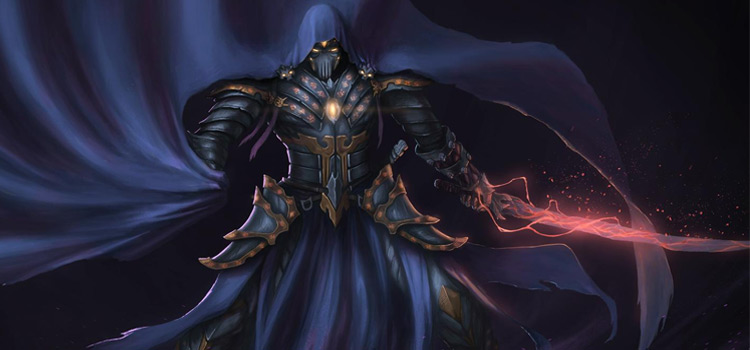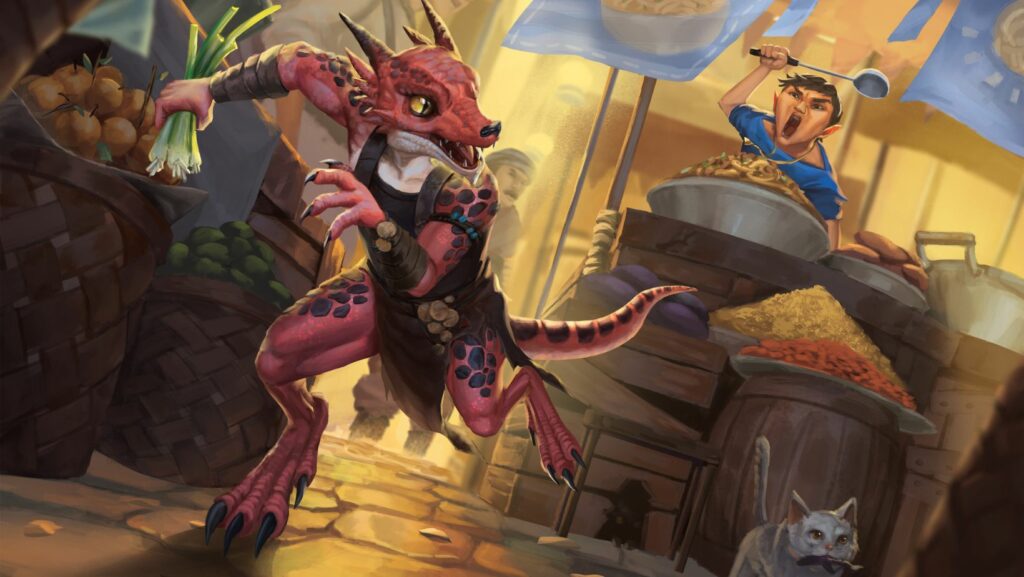The Xanathar’s Guide to Everything is a D&D supplement that provides an alternative way of playing Dungeons and Dragons. One such spell is Shadow Blade. This guide will help you figure out what the spell does, how it works, and who can cast it! Also check out Dice Goblin for all D&D accessories to aid you in your adventure,
“You can throw it like a handaxe for extra damage (2d8 psychic plus your attack ability modifier). When you cast it with a higher-level slot, the damage increases to 5d8. It vanishes after your turn if you drop or throw it as an attack.”
What Does It Do?
Shadow Blade
- School: Illusion
- Level: 2
- Casting Time: One Bonus Action
- Range/Area: Self
- Components: V, S
- Duration: One Minute (Concentration)
The Shadow blade lets you create a shadowy duplicate of yourself that can attack your enemies. You may form a sword of darkness in your hand with this spell, which counts as a weapon that you can use to make attacks. It’s a straightforward melee weapon that any caster who casts the spell is familiar with.
It has finesse, allowing you to make a Strength or Dexterity attack. You can throw it like a handaxe for extra damage (2d8 psychic plus your attack ability modifier). When you cast it with a higher-level slot, the damage increases to 5d8. It vanishes after your turn if you drop or throw it as an attack. And you can call it back with a bonus action provided that you are still concentrating on the spell. One of its benefits is the advantage gained from making attacks in darkness. Whenk.
How Does Shadow Blade Work?
When you cast the spell, you create a duplicate of yourself that is made out of a shadow. This duplicate can move and attack as normal, but it has only half your hit points. The duplicate also disappears if it drops to 0 hit points or if you dismiss it as a bonus action.
The spell is available to Sorcerers, Warlocks, and Wizards as a member of their class’ spell lists. Bards may learn it as one of their Magical Secrets, while Arcane Trickster Rogues and Eldritch Knight Fighters get it from the Wizard list. Other classes might learn it by multiclassing and investing at least 3 levels into Sorcerer
Uses For Shadow Blade
The technique for creating a dark blade is straightforward. You make a sword that you can use to attack. It’s a useful spell, especially if you have the dark vision. But we may also look at different classes in further detail.
1. Warlocks
When it comes to warlocks, a shadow blade is an… intriguing spell. Shadow blade is a concentration spell, so if you have Devil’s Sight, it competes with hex and dark. If you’re lucky enough to have a Shadow Sorcerer in your party, he or she may cast the darkness spell for you. Because darkness would give you an
The Shadow Blade can’t be used with the Pact of the Blade or Hexblade’s Hex Warrior feature. If you want to dual-wield, you can use shadow blade in your off hand; however, none of your Blade Pact abilities are compatible with it. For non-Pact of the Blade warlocks, it’s a lot of fun to throw knives at each other. It’s more viable when combined with a cantrip like green flame blade. However, you’ll generally have better damage-dealing alternatives if you have access to eldritch blast, Agonizing Blast invocation, and hex.
2. Eldritch Knight Fighters
Pros
For Eldritch Knights, the spell is fantastic. You won’t be able to obtain the spell until level 8—it’s an illusion spell, so you’ll have to select it when you can pick from any school of magic. You don’t need a high Intelligence modifier to utilize the spell, which is excellent.
When you do get the spell, you may create a blade that does more damage than a greatsword. Plus, it can be used with a shield for extra AC. When you reach level 13 and acquire 3rd-level spell slots, you may now make a shadow blade that deals 3d8 damage on hit. Those additional dice can be quite
Cons
You must focus on the spell. This implies you run the danger of losing it if you take too much damage. It also competes with other spells that you want to concentrate on, such as haste. If you can find a Flame Tongue or another magic weapon with a high number of damage dice, go for it instead.
Concentration is reduced by 15%, but you may use bonus spells from your order, auras, and other effects to assist. You may cast haste for additional attacks and another bonus to protection by freeing up spell slots. Shadow blade might be a decent choice as an alternative to magic items if your campaign has few of them.
3. Arcane Trickster Rogues
On Arcane Tricksters, a glittering blade is acceptable. It does extra damage, but you only get one additional attack. As a result, it isn’t as effective as on an Eldritch Knight.
You’ll need a lot more Sneak Attack damage if you want to deal much damage. Shadow blade can assist if you require an advantage for the Sneak Attack in light or darkness and are in dim light or darkness. Although your Versatile Trickster ability provides you with another means to exploit mage hand, it’s more difficult to set up.
It takes two bonus actions to use it, one to cast it as an action, one to move the hand, and another to gain an advantage from it. The bonus action option is one of the more complicated features of the game. The quick blade is simpler and doesn’t consume your bonus action every round.
Shadow Blade is a fast weapon that excels at dealing damage over time. Combine it with the Green Flame Blade or the Booming Blade to boost shadow blade’s psychic damage and add fire or thunder damage to its Sneak Attack.
4. Sorcerers
Sorcerers are typically rather squishy. And a spell intended for combat isn’t generally their specialty. This spell, on the other hand, has no effect on sorcerers. However, there are some interesting interactions between this prayer and sorcery. And if you really want to get up in somebody’s face, it has a lot of strong alternatives.
Shadow Blade is a great choice for spellcasters who have the sorcery points to burn. Then, using your action, cast the booming blade cantrip twice with your Twinned Spell metamagic (Twinned Spell does not work with green flame blade sadly). On later turns, you may begin your turn by Quickening another exploding blade for three powerful melee assaults.
Pros
Scimitars are the most effective weapons in dim light or darkness, and especially if you’re an elf with Elven Accuracy. You can cast up to three blade cantrips in a turn with your Twinned Spell and Quickened Spell metamagics, which is no small feat. At 17th level, each of your three attacks with shadow blade and booming blade deals 5d8 psychic and 3d8 thunder damage to the target, plus an extra 4d8 thunder damage if they move.
The additional thunder damage from the roaring blade does not stack on a single target. However, by threatening them with loud damage, you may attempt to isolate several opponents and prevent them from attacking you. When combined with the Mobile feat, you may restrict them and keep running unrestrained.
“Scimitars are the most effective weapons in dim light or darkness, and especially if you’re an elf with Elven Accuracy. You can cast up to three blade cantrips in a turn with your Twinned Spell and Quickened Spell metamagics, which is no small feat.”
The damage caused by the swarm is not all in one place, instead, it spreads out across the entire battlefield. That’s why this type of attack works well with everything from area effects to AoE attacks that damage multiple targets at once. The third and fourth forms fire 3 missiles each round (3d6). Each missile has a base range of 150 feet 9th-level spells provide a lot of alternatives. Shadow blade + booming blade may not be your finest trick in every scenario, but if you need or want to get into melee, it’s very useful. Don’t argue with anything that’s not susceptible to psychic or thunder attacks.
Cons
Even if you can consistently secure triple advantage with Elven Accuracy, you’ll want a decent attack modifier. With the right equipment, you can now hit a man-sized or larger target with most bows at least three times out of four. The lethality of archery has skyrocketed in recent years as firearm power has risen, and modern compound bows can pierce up to 10 feet through chainmail. This means that high Dexterity or Strength is required for it to perform at its maximum.
This combination is made to combat many opponents. If you want to utilize Twinned Spell, you’ll need a backup target, and if none are close enough, you’re out of luck. This method also uses up sorcery points.
If you want to keep them, stick to the twinning booming blade, which is half the price of a Quickened Spell metamagic. That’s two attacks with the bludgeoning blade. If you can get your hands on a set of Illusionist’s Bracers, you won’t have to spend sorce points on Quickened Spell. It’s even better than you think because the bracers allow you to cast a cantrip as a bonus action without requiring any supplies or components.
That implies that you can now Twin your bonus action booming blade for a total of four assaults with the cantrip. If you can get a pair of these bracelets (from Guildmasters’ Guide to Ravnica) and figure out how to safeguard your sorcerer from attacks from his or her foes, you’ll be an absolute beast on the field… as long as you’re up against more than one opponent.
5. Wizards and Bards
The Greataxe has a two-handed animation and is ideal for those who favor strength over accuracy, though it lacks the Battle focus on the video game. The Battle Focus perk improves its critical damage (by 20%). It also has an exotic look to it that sets it apart from other axes. This axe might be used by a Bladesinger wizard, the College of Swords Bard, and the College of Valor Bard.
Shadow Blade is a little more useful for the three subclasses if they all have Extra Attack. Regardless of the class, if a bard or wizard is forced into melee, the spell is ineffective.
Pros
There’s a decent chance all three subclasses will have high Dexterity, so you don’t have to worry about improving another ability score. Swords bards, on the other hand, prefer to focus on melee strikes in order to utilize their flourishes. Since they may use flourishes effectively at higher levels for free, shadow blade is a fantastic method to boost their damage.
It still competes with high-level spells, but it is a method that allows them to deal significant damage and utilize their bonus action to bestow Bardic Inspiration or cast other bonus action spells like healing word. After casting a spell, the Valor bard gains the ability to make a weapon attack. You can use your bonus action to make an attack with shadow blade, then pop the green flame blade for additional damage.
You would need to invest in two Magical Secrets in order to master shadow blade and green flame blade, which is a little pricey. The Bladesinger’s Song of Victory ability increases the Strength damage dealt by Dexterity based weapons. That makes shadow blade a bit more appealing at higher levels. However, you’ll only be able to cast two attacks, and these attacks will have to compete with the wizard’s extensive arsenal of devastating spells.
Cons
The ability to use shadow blade is restricted to bards who have multiclass or who take one of their Magical Secrets, which may be a difficult task when the game features fireball or counterspell. Starting at the 11th level, the wizard can use Tenser’s transformation as well. Magical Secrets is also available to bards.
In essence, the Tenser Model is made on the same principle as the Purebloods (and they are almost identical in abilities), however with a few modifications. Unlike shadow blade, Tenser’s transformation does not require a lack of light to provide a benefit. It also gives Wizards with Extra Attack who don’t already have it, a few saving throw proficiencies, and a good number of temporary hit points.
Tenser’s transformation is a fantastic spell for wizards looking to get into melee, but it comes at the expense of not being able to use spells while concentrating on it. Shadow blade is a high-level spell with significant limitations. It’s tough for it to keep up with so many other amazing spells. In conclusion, shadow blade can be a fantastic spell for bards who multiclass or take Magical Secrets, but the Tenser Model is more versatile.
















